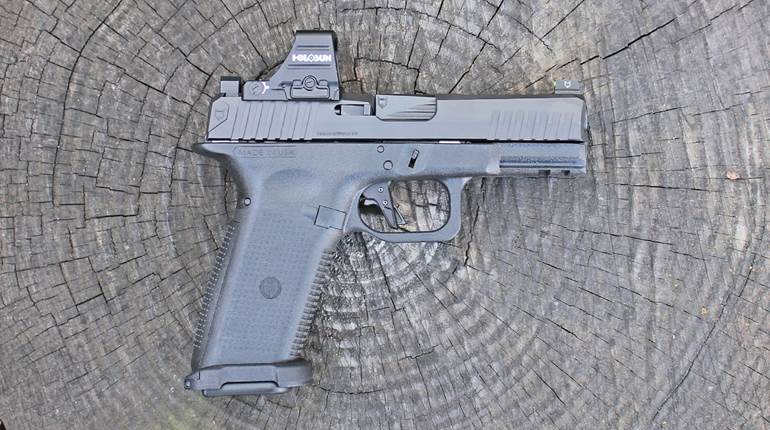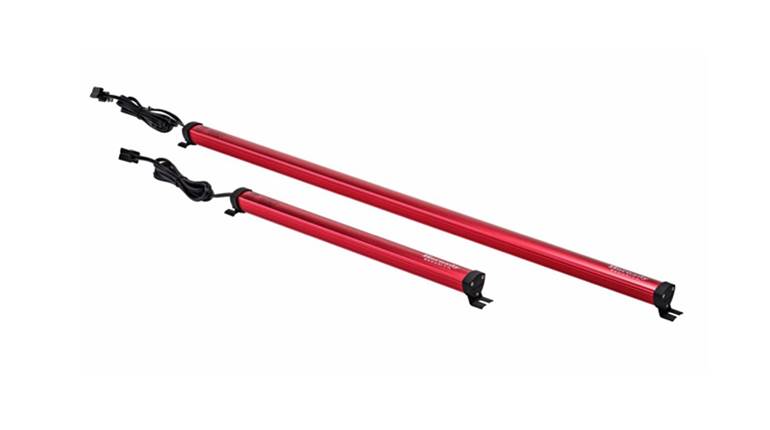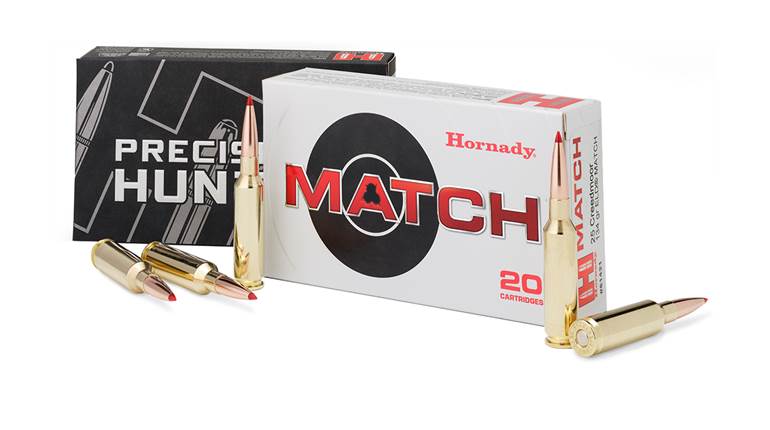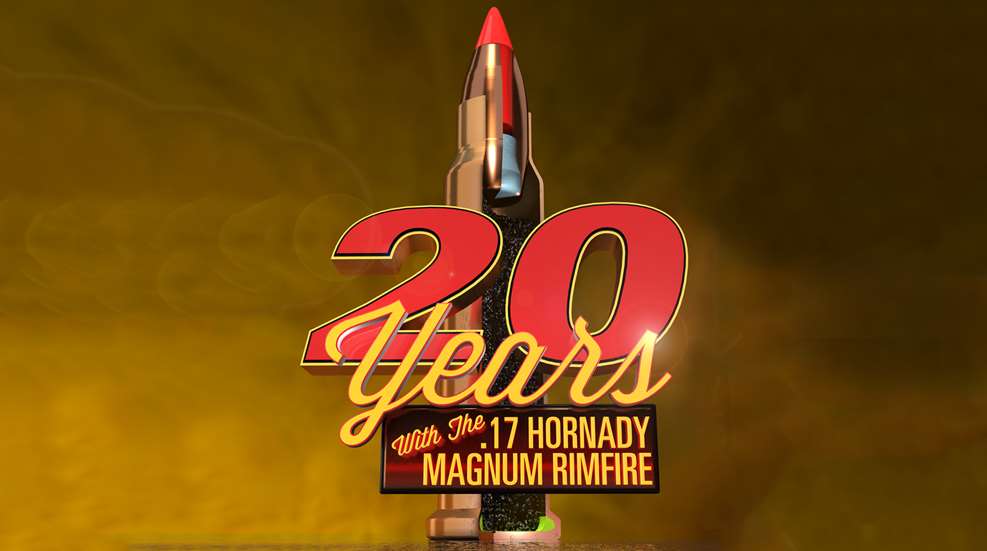
Time flies when you’re having fun. It’s been 20 years of shooting enjoyment since Hornady introduced its .17 Hornady Magnum Rimfire in 2002. The .17’s launch was a bold move by the manufacturer, going up against the crowded rimfire market filled with .22 Long Rifle (LR) loads and the long-established .22 Winchester Magnum Rimfire (WMR).
David Emary, Hornady’s senior ballistic scientist at the time, partnered with the Marlin and Ruger firearm companies and CCI, a leader in rimfire cartridge development, to create the cartridge. The .17’s premise was speed, a flat trajectory and accuracy.
The new .17 HMR was viewed with skepticism back in 2002. Its 17-grain V-Max bullet weighed less than half that of the .22 magnum’s standard-weight bullet. And because a 50-count box of .17s cost a couple of dollars more than .22 WMR—and at least five times that of .22 Long Rifle—I was among the skeptics. No way, I thought, was anyone going to shoot such a relatively expensive cartridge to plink at pinecones or drill holes in targets. While the .17’s lightweight bullet might pack enough punch for pint-sized ground squirrels and such, surely the bullet would lack enough of a knockout punch for larger game such as marmots and fox.
My conviction started to change when empty .17 HMR cases began covering the ground like gravel at the local shooting range. Not nearly as many as fired .22 LR cases, but still a significant number, and way more than .22 WMR empties. A few years after the .17 was introduced, I was at the local shooting range when a man drove up in an expensive SUV. He took a cardboard box out of his vehicle and placed it on the shooting bench next to me. With the twinkle in his eye of a boy on Christmas morning, he carefully opened the box and lifted out a Ruger 77/17 rifle. The rifle wore an expensive variable-power scope.
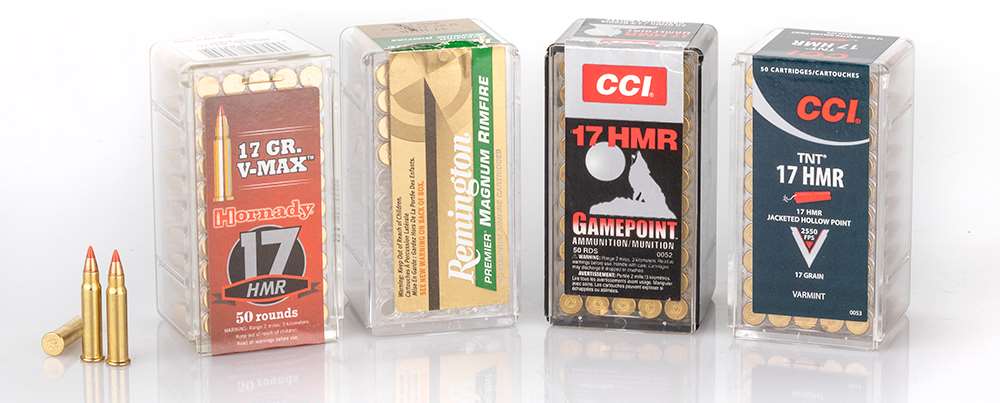
As he went about sighting-in the rifle, he explained why he liked the .17 HMR so much; he wanted to shoot during the little spare time he had, not reload spent rounds. While he’d paid good money for .17 HMR cartridges, it was still less expensive than .22 Hornet or .223 Rem. ammunition. The .17 shot flat and accurately out to 150 yards and produced next to no recoil so he could see his bullets hit—instant gratification. He held up a cartridge. The bullet’s red tip shined in the sunlight. “It’s just plain fun to shoot,” he said.
Shooting the .17 HMR myself also won me over. A Cooper Model 57-M commonly fired five Hornady Varmint Express 17-grain V-Max bullets inside an inch at 100 yards. A Ruger 77/17 was close behind. Over the seasons, I’ve shot those rifles and several other .17 rifles during outings for ground squirrels and prairie dogs. V-Max bullets zeroed at 50 yards came back on aim at 100 yards and dropped 2.5" at 150 yards. Stretching shots to 200 yards required a holdover of about 7.5" and nearly a foot of horizontal holdoff to compensate for the ever-present wind. There wasn’t a penny’s worth of difference in bullet performance and trajectory between the .17 HMR and .22 WMR, shooting 30-grain bullets, out to 100 yards. Past that distance, the .22 magnum really dropped off, with nearly twice as much bullet drop at 150 and 200 yards as the .17.
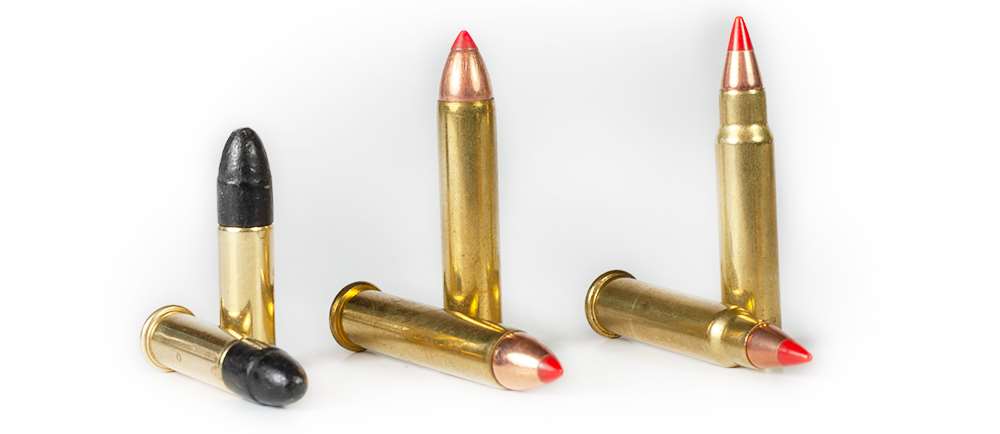
Production & Performance
Whether the name printed on the box is Browning, CCI, Federal, Hornady, Norma, Remington or Winchester, the vast majority of .17 HMR cartridges are manufactured by CCI in Lewiston, Idaho. The .17’s relatively high velocity requires a bullet with a copper-alloy jacket, and Hornady supplies the bulk of those bullets, such as its V-Max. “These are precision-swaged bullets made on the same machines as Hornady makes other cup-and-core bullets,” said Seth Swerczek, Hornady’s marketing communications manager. “The .17 is amazingly accurate, and it should be, because V-Max bullets commonly shoot groups measuring tenths of an inch at 100 yards.”
Bullet weights and styles vary from Hornady’s 15.5-grain copper-alloy-core NTX and CCI’s 16-grain TNT Green to the polymer-tipped 17-grain V-Max and 20-grain full metal jackets, hollow points and soft points. The .17 HMR’s common 1:9" rifling twist could stabilize bullets weighing up to 25 grains or so. But that heavy of a bullet would significantly decrease velocity by about 500 f.p.s.
Manufacturing .17 HMR cartridges requires a few more, and more intricate, steps than creating .22 rimfire cartridges. Justin Ruegsegger is the engineering director for CCI in Lewiston, Idaho, and he said production of .17 HMR cartridges starts with .22 WMR cases. Because of the .17’s narrow neck, though, priming compound must be inserted into the cases before they are necked down to .17 cal. The stroke of a die to form necks could feasibly set off the priming. “But we have figured out how to do it safely,” he said. Inserting propellant through the narrow neck is also challenging at the rate necessary to make thousands upon thousands of rounds a day.
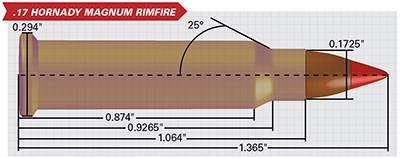 When CCI started manufacturing .17 HMR 20 years ago, the case neck split on some cartridges. The result was insufficient neck tension on bullets that caused the cartridge’s relatively slow-burning propellant to fail to ignite. “But primers did fire, and that was enough to lodge a bullet in the barrel bore,” Ruegsegger said, “and that could lead to a catastrophic failure if another cartridge was chambered and fired.”
When CCI started manufacturing .17 HMR 20 years ago, the case neck split on some cartridges. The result was insufficient neck tension on bullets that caused the cartridge’s relatively slow-burning propellant to fail to ignite. “But primers did fire, and that was enough to lodge a bullet in the barrel bore,” Ruegsegger said, “and that could lead to a catastrophic failure if another cartridge was chambered and fired.”
The solution to these splits was to stress-relief the necks by annealing them after they were formed. Annealing is usually accomplished by applying heat, but the presence of priming compound inside the cases eliminated that option. “It took us quite a while to figure it out,” Ruegsegger said. “Let’s just say we don’t anneal with heat, and the rest is a trade secret.”
I’ve found the velocities stated on factory .17 HMR boxes to be approximate and often understated. For example, shot from the 22" barrel of a Browning T-Bolt, Winchester’s 17-grain Varmint HV V-Max clocked 2,588 f.p.s. and Super-X 20-grain XTPs measured 2,339 f.p.s. By comparison, Winchester 17-grain V-Max registered 2,515 f.p.s. shot from the 22" barrel of a Cooper M57-M Jackson Squirrel Rifle. Hornady Varmint Express 17-grain V-Max loads turned in a speed of 2,627 f.p.s., shot from a Cooper 57-M Varminter’s 24" barrel. As the nearby load chart shows, Hornady Varmint Express 17-grain V-Max loads averaged 2,639 f.p.s., 20-grain HP XTP averaged 2,378 f.p.s. and 15.5-grain NTX loads averaged 2,730 f.p.s. shot from the 24.8" barrel of a CZ 457. The speeds from the CZ are about spot-on for the 20-grain bullet to 200 f.p.s. faster for the 15.5-grain bullet than the velocities stated by Hornady.
I shot the 17-grain V-Max load from a CZ 457 American at 100 and 200 yards to determine if my chronograph was optimistic in its readings. With the bullets hitting on point of aim at 100 yards, they dropped 7" at 200 yards. That was right in line with the trajectory calculated by a ballistic program for the bullets fired at 2,639 f.p.s.
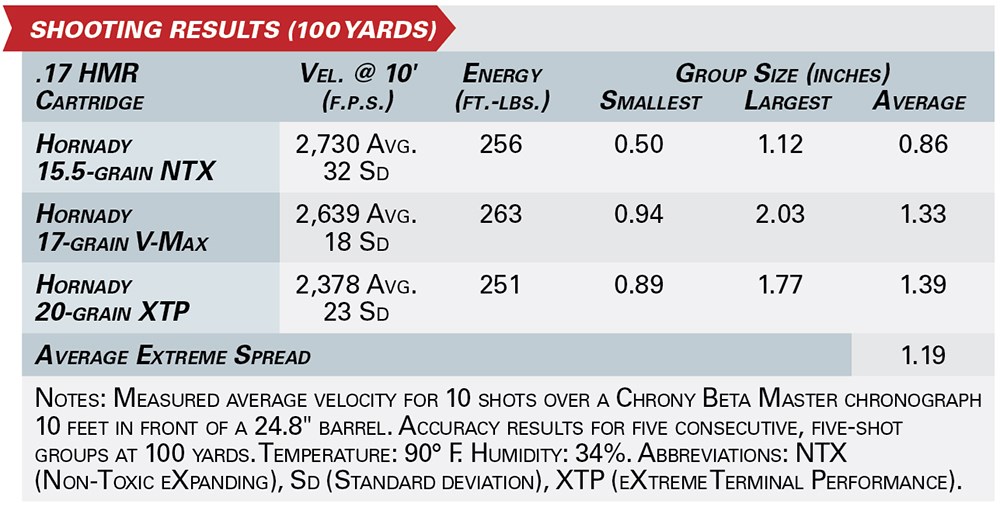
The wind was blowing every which way the evening that I shot the CZ way out there at 200 yards. Five-shot groups averaged about 4" with a mostly horizontal spread. I waited until the wind died down and fired a shot. Waiting to fire four following shots through still air took so long that prairie dogs might well have gone into their burrows to hibernate for the winter. Finally, however, the five-shot group measured a satisfying 1.54".
At CCI, one production line is dedicated to the .17 HMR and another to the .22 WMR. “Offhand, I’d say we make more .17s than .22 magnums,” Ruegsegger said. “But not by much, because there are a lot of .22 magnum rifles out there.”
Swerczek attributes the .17 HMR’s initial and continuing popularity to the extensive models of guns chambered for the cartridge. Guns suitable for the .22 WMR were a ready vehicle for the .17, as the .17 HMR’s maximum average pressure is set at 26,000 p.s.i., compared to 24,000 p.s.i. for the .22 WMR. Years ago, when CZ introduced the Mini Set in its 455 rifle, it came with interchangeable .17 HMR, .22 LR and .22 WMR barrels. However, the current CZ 457 American Combo does not include a .22 WMR barrel, which suggests that the .17 has taken center stage.
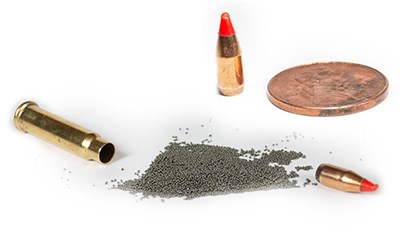 Host Platforms
Host Platforms
Marlin and Ruger were the first to introduce bolt-action rifles for the .17. Their immediate success opened the floodgates, as 2002 was a less-than-stellar year for firearm sales, and other companies immediately chambered the new cartridge in hopes of boosting their sales. Ruger currently chambers the .17 HMR in its American Rimfire bolt-action, and Marlin did the same in its XT-17 bolt-action produced until 2020.
Today it might be easier to list what rimfire guns aren’t chambered in .17 HMR. A sample, though, includes upscale rifles from Anschutz, with seven styles of its Model 1761 bolt-action, and Cooper Firearms, with several versions of its M57-M bolt-action. CZ offers five varieties of its 457 bolt-action, Henry makes its lever-action Varmint Express and Rossi offers its bolt-action Youth Rifle.
Swerczek and Ruegsegger agree that the .17 HMR cycles best through a manually operated bolt-action rifle. However, the .17 has been especially popular chambered in the relatively inexpensive Savage A17 semi-automatic rifle. CCI engineers worked with Savage to design and test the A17 when both companies were under the same corporate umbrella. CCI even developed its A17 Varmint Tip load expressly for the Savage rifle. “The A17 load uses the same 17-grain V-Max bullet as other loads,” Ruegsegger said, “but with a different propellant to assure feeding and function.” The A17 load fires V-Max bullets at 2,650 f.p.s., a gain of 100 f.p.s. over other loads firing the same bullet.
The .17 HMR has also crossed over a bit into handguns. For a number of years, the .17 was chambered in Smith & Wesson’s Model 647 revolver and a few others. However, Thompson/Center G2 Contender single-shots and Ruger Single-Six and Taurus Tracker revolvers are about all that remain of those handguns.
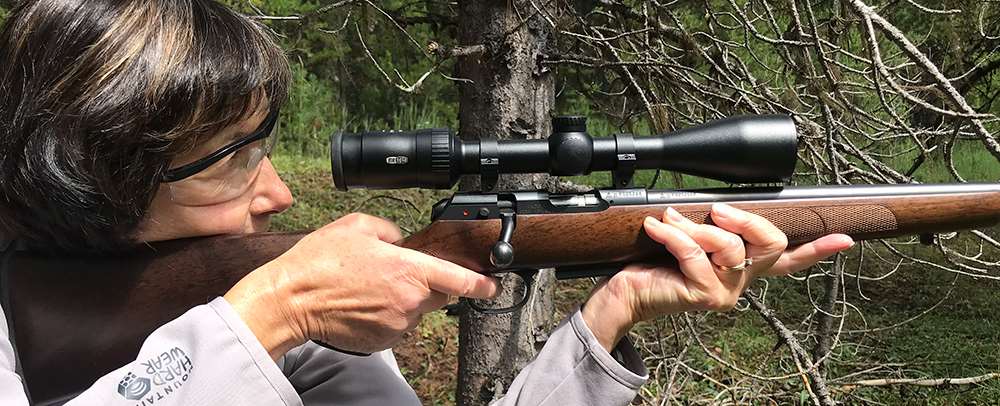
Time Afield
During Swerczek’s days of answering Hornady customer service phone calls, he heard from many callers who said they used their .17 HMR rifles to take game as large as fox and coyotes. Mostly, though, they shot smaller game such as crows, ground squirrels and prairie dogs.
My aim was prairie dogs last spring on the Wyoming plains with Swerczek and a couple of other fellows. Kelly Glause, of Cole Creek Outfitters in Evansville, Wyo., shepherded us around the low hills and creek-bottom hayfields. Swerczek is a former Marine and knows his way around a rifle. I didn’t completely embarrass myself attempting to keep pace with him while I was shooting my CZ 457 .17 HMR. Somewhere in a back corner of the Hornady ballistic lab, Swerczek had found a Smith & Wesson Model 647 revolver chambered in .17 HMR. A low-magnification scope on the revolver provided a precise aim, and Swerczek connected on quite a few shots from 60 to 100 yards. The Wyoming wind wanes and waxes and only stops to change direction, which threw a wrench into my shooting success much past 100 yards.
According to Swerczek, more than a billion .17 HMR rounds have now been sold since the cartridge was introduced 20 years ago, and I have done my part to contribute to that count. Shadows lengthened as day turned to evening and our prairie dog hunt drew to a close. Like I said before: Time sure does fly when you’re having fun.












